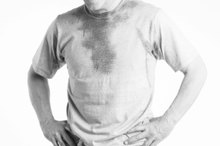Heavy Breathing During Exercise
Strenuous exercise, especially when you are not used to exercising regularly, can cause difficulty breathing. Heavy breathing is the body’s way of delivering more oxygen to the cells.
Heavy breathing during exercise is not necessarily cause for concern unless you have an underlying medical problem.
Oftentimes, shortness of breath is due to physical deconditioning. If the symptom seems unusual, talk to your health care provider about ruling out other causes.
Exercise-Induced Asthma
Aerobic activities that make you breathe hard can trigger symptoms of exercise induced-asthma. Exercising in cold weather can also bring on symptoms such as wheezing, coughing, shortness of breath and chest tightness or pain. Breathing involves moving air in and out of the lungs. Feeling a little out of breath when you exercise is normal, but if you have exercise-induced asthma, your symptoms may be more severe. Your symptoms might not be related to being out of shape or having poor endurance. Exercise-induced asthma rather than exertion could be causing your airways to tighten.
- Aerobic activities that make you breathe hard can trigger symptoms of exercise induced-asthma.
- Exercise-induced asthma rather than exertion could be causing your airways to tighten.
Angina
What Is Mild Hyperinflation?
Learn More
Although heart attacks do not normally occur during exercise, exercise is often associated with angina.
Symptoms include finding yourself suddenly winded after physical activity or chest pain that comes on with physical exertion and eases with rest. Physical exertion makes the heart beat faster.
But when the heart muscle can’t get enough oxygen, pain may occur.
Although angina can be painful and scary, it’s an early warning sign of heart disease. Knowing that something isn't right could save your life.
- Although heart attacks do not normally occur during exercise, exercise is often associated with angina.
- But when the heart muscle can’t get enough oxygen, pain may occur.
Pulmonary Disorders
Dyspnea, or shortness of breath, is characterized by labored breathing. Bronchitis, asthma, emphysema, chronic destructive pulmonary disease, or COPD, and pulmonary hypertension can cause chronic dyspnea. Smoking also interferes with oxygen transport in the body. Symptoms of COPD in smokers include shortness of breath and chronic cough. You can exercise even if you have these medical conditions.
Strengthening the chest muscles helps decrease shortness of breath. Walking is an exercise you can do at your own pace. Try to walk a short distance every day. Build up to walking longer distances by walking farther each day than you did the day before.
- Dyspnea, or shortness of breath, is characterized by labored breathing.
- Build up to walking longer distances by walking farther each day than you did the day before.
Anemia/Thyroid Disease
What Causes Shortness of Breath When Talking?
Learn More
Anemia and thyroid dysfunction are other medical conditions that can cause shortness of breath. Individuals who are severely anemic often get short of breath when they exercise vigorously. People with anemia have a red blood cell count that is less than normal. The cells need oxygen to produce energy. Red blood cells are what deliver oxygen and remove carbon dioxide from the body’s tissues. Individuals who have hypothyroidism can have weakened respiratory muscles. This decreases lung function.
As a result, people with underactive thyroid may suffer fatigue and shortness on breath on exertion. These symptoms can decrease a person’s ability to exercise.
- Anemia and thyroid dysfunction are other medical conditions that can cause shortness of breath.
- Individuals who are severely anemic often get short of breath when they exercise vigorously.
Related Articles
References
- Mayo Clinic: Exercise-Induced Asthma
- National Heart, Lung and Blood Institute: What Causes Angina?
- National Lung Health Education Program: Treatment of COPD and Asthma
- ScienceDaily: Even Mild Thyroid Problems Double Risk of Heart Condition
- Wahls SA. Causes and evaluation of chronic dyspnea. Am Fam Physician. 2012;86(2):173-82.
- John Hopkins University. Heart & Vascular Institute. Shortness of breath. Updated 2019.
- Whited L, Graham DD. Abnormal respirations. [Updated 2019 Jul 30]. In: StatPearls [Internet]. Treasure Island (FL): StatPearls Publishing; 2019.
- Chourpiliadis C, Bhardwaj A. Physiology, respiratory rate. [Updated 2019 Jan 28]. In: StatPearls [Internet]. Treasure Island (FL): StatPearls Publishing; 2019.
- Abidov A, Rozanski A, Hachamovitch R, et al. Prognostic significance of dyspnea in patients referred for cardiac stress testing. N Engl J Med. 2005;353(18):1889-98. doi:10.1056/NEJMoa042741
- Cleveland Clinic. Emphysema: Diagnosis and tests. Updated August 9, 2019.
- Munari AB, Gulart AA, Dos santos K, Venâncio RS, Karloh M, Mayer AF. Modified Medical Research Council dyspnea scale in GOLD Classification better reflects physical activities of daily living. Respir Care. 2018;63(1):77-85. doi:10.4187/respcare.05636
- Guly HR. ABCDEs. Emerg Med J. 2003;20(4):358. doi:10.1136/emj.20.4.358
- Kasper DL, Fauci AS, Hauser SL. Harrison's Principles of Internal Medicine. New York: Mc Graw Hill education, 2015.
- MedlinePlus. Breathing difficulty. Updated 03/05/18.
- Nishino T. Dyspnoea: underlying mechanisms and treatment. British Journal of Anaesthesia. 2011;106(4):463-74. doi:10.1093/bja/aer040
Writer Bio
Amber Keefer has more than 25 years of experience working in the fields of human services and health care administration. Writing professionally since 1997, she has written articles covering business and finance, health, fitness, parenting and senior living issues for both print and online publications. Keefer holds a B.A. from Bloomsburg University of Pennsylvania and an M.B.A. in health care management from Baker College.









